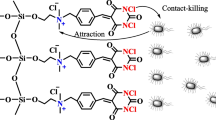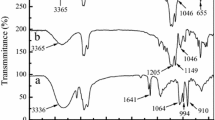Abstract
Tuning the ratio of complementary biocidal groups in a composite unit is proved to be a tactic to better minimize their weaknesses to realize higher synergism. A silane with precursors of one pyridinium and two N-chloramine sites, 6-(pyridin-4-yl)-3-(3-(trimethoxysilyl)propyl)-1,3,5-triazinane-2,4-dione, was synthesized, hydrolyzed and dehydrocondensed into a silicone modifier on cotton cellulose. Specially, isonicotinaldehyde was ammonolyzed with biuret to produce 6-(pyridin-4-yl)-1,3,5-triazinane-2,4-dione that subsequently reacted with (γ-chloropropyl)trimethoxysilane to synthesize the silane through nucleophilic substitution. The modifier on cotton was quaternized and chlorinated to transform the one pyridine and two amide N–H structures in each unit of the silicone to pyridinium and N-chloramine counterparts. The cationic pyridinium increases the hydrophilicity of the unit and draws anionic bacteria to its two adjacent highly fatal N-chloramine sites, achieving a faster contact-killing rate than not only monofunctionality but also basic synergistic integration of one cationic center and one N-chloramine. This phenomenon is therefore referred to as “intensified synergism” and provides crucial information for the design of more powerful biocides. The pyridinium/di-N-chloramine silicone coating exhibited extraordinary durability towards UV irradiation, washing cycles and long-term storage due to the good UV resistance and chemical inertness of pyridinium and silicone backbone.
Graphic abstract








Similar content being viewed by others
Data availability
All data generated or analysed during this study are included in this article.
References
Ates B, Cerkez I (2017) Dual antibacterial functional regenerated cellulose fibers. J Appl Polym Sci 134:44872
Cao Z, Sun Y (2008) N-halamine-based chitosan: preparation, characterization, and antimicrobial function. J Biomed Mater Res, Part A 85:99–107
Cerkez I, Kocer HB, Worley SD, Broughton RM, Huang TS (2011) N-halamine biocidal coatings via a layer-by-layer assembly technique. Langmuir 27:4091–4097
Cerkez I, Kocer HB, Worley SD, Broughton RM, Huang TS (2016) Antimicrobial functionalization of poly(ethylene terephthalate) fabrics with waterborne N-halamine epoxides. J Appl Polym Sci 133:43088
Chen Y, Niu M, Yuan S, Teng H (2013) Durable antimicrobial finishing of cellulose with QSA silicone by supercritical adsorption. Appl Surf Sci 264:171–175
Chen X, Hu B, **ng X, Liu Z, Zuo Y, **ang Q (2015a) Preparation of grafted cationic polymer/silver chloride modified cellulose fibers and their antibacterial properties. J Appl Polym Sci 132:42092
Chen Y, Han Q, Wang Y, Zhang Q, Qiao X (2015b) Synthesis of pyridinium polysiloxane for antibacterial coating in supercritical carbon dioxide. J Appl Polym Sci 132:41723
Chen Y, Ma Y, He Q, Han Q, Zhang Q, Chen Q (2019) Construction of pyridinium/N-chloramine polysiloxane on cellulose for synergistic biocidal application. Cellulose 26:5033–5049
Chen Y, Wang Y, Feng C, He Q, Chen Q, Wang Z, Han Q (2020) Novel quat/di-N-halamines silane unit with enhanced synergism polymerized on cellulose for development of superior biocidability. Int J Biol Macromol 154:173–181
Cheng X, Li R, Du J, Sheng J, Ma K, Ren X, Huang T-S (2015) Antimicrobial activity of hydrophobic cotton coated with N-halamine. Polym Adv Technol 26:99–103
Ding X, Duan S, Ding X, Liu R, Xu F-J (2018) Versatile antibacterial materials: an emerging arsenal for combatting bacterial pathogens. Adv Funct Mater 28:1802140
Dong A, Zhang Q, Wang T, Wang W, Liu F, Gao G (2010) Immobilization of cyclic N-Halamine on polystyrene-functionalized silica nanoparticles: synthesis, characterization, and biocidal activity. J Phy Chem C 114:17298–17303
Dong A, Xue M, Lan S, Wang Q, Zhao Y, Wang Y, Zhang Y, Gao G, Liu F, Harnoode C (2014) Bactericidal evaluation of N-halamine-functionalized silica nanoparticles based on barbituric acid. Colloids Surf B 113:450–457
El-Rafie M, Ahmed HB, Zahran M (2014) Characterization of nanosilver coated cotton fabrics and evaluation of its antibacterial efficacy. Carbohydr Polym 107:174–181
Gomes AP, Mano JF, Queiroz JA, Gouveia IC (2015) Layer-by-layer assembly for biofunctionalization of cellulosic fibers with emergent antimicrobial agents. Adv Polym Sci 2016:225–240
Hu B, Chen X, Zuo Y, Liu Z, **ng X (2014) Dual action bactericides: quaternary ammonium/N-halamine-functionalized cellulose fiber. J Appl Polym Sci 131:40070
Ibrahim MM, Mezni A, El-Sheshtawy HS, Abu Zaid AA, Alsawat M, El-Shafi N, Ahmed SI, Shaltout AA, Amin MA, Kumeria T, Altalhi T (2019) Direct Z-scheme of Cu2O/TiO2 enhanced self-cleaning, antibacterial activity, and UV protection of cotton fiber under sunlight. Appl Surf Sci 479:953–962
Jiang Z, Ma K, Du J, Li R, Ren X, Huang T (2014) Synthesis of novel reactive N-halamine precursors and application in antimicrobial cellulose. Appl Surf Sci 288:518–523
Kang Z-Z, Zhang B, Jiao Y-C, Xu Y-H, He Q-Z, Liang J (2013) High-efficacy antimicrobial cellulose grafted by a novel quaternarized N-halamine. Cellulose 20:885–893
Kocer HB, Cerkez I, Worley SD, Broughton RM, Huang TS (2011) Polymeric antimicrobial N-halamine epoxides. ACS Appl Mater Interfaces 3:2845–2850
Kou L, Liang J, Ren X, Kocer HB, Worley S, Broughton R, Huang T (2009) Novel N-halamine silanes. Colloids Surf A 345:88–94
Krishnan S, Ward RJ, Hexemer A, Sohn KE, Lee KL, Angert ER, Fischer DA, Kramer EJ, Ober CK (2006) Surfaces of fluorinated pyridinium block copolymers with enhanced antibacterial activity. Langmuir 22:11255–11266
Li L, Pu T, Zhanel G, Zhao N, Ens W, Liu S (2012) New biocide with both N-chloramine and quaternary ammonium moieties exerts enhanced bactericidal activity. Adv Healthcare Mater 1:609–620
Li, L., Zhao, Y., Zhou, H., Ning, A., Zhang, F., Zhao, Z. (2016) Synthesis of pyridinium N -chloramines for antibacterial applications. Tetrahedron Lett.
Liang J, Chen Y, Barnes K, Wu R, Worley SD, Huang TS (2006) N-halamine/quat siloxane copolymers for use in biocidal coatings. Biomaterials 27:2495–2501
Liang J, Wu R, Wang JW, Barnes K, Worley SD, Cho U, Lee J, Broughton RM, Huang TS (2007) N-halamine biocidal coatings. J Ind Microbiol Biotechnol 34:157–163
Liu Y, Ma K, Li R, Ren X, Huang TS (2013) Antibacterial cotton treated with N-halamine and quaternary ammonium salt. Cellulose 20:3123–3130
Liu XY, Ma LL, Chen F, Liu JZ, Yang H, Lu Z (2019) Synergistic antibacterial mechanism of Bi2Te3 nanoparticles combined with the ineffective beta-lactam antibiotic cefotaxime against methicillin-resistant Staphylococcus aureus. J Inorg Biochem 196:8
Luo J, Sun Y (2006) Acyclic N-halamine-based fibrous materials: preparation, characterization, and biocidal functions. J Polym Sci Part a: Polym Chem 44:3588–3600
Luo G, ** G, Wang X, Qin D, Zhang Y, Fu F, Liu X (2017) Antibacterial N -halamine coating on cotton fabric fabricated using mist polymerization. J Appl Polym Sci 134:44897
Ma W, Wang T, Li H, Zhang S (2015) Cotton fabric modification through ceric (IV) ion-initiated graft copolymerisation of 2-methacryloyloxyethyltrimethyl ammonium chloride to enhance the fixation of reactive dyes. Cellulose 22:4035–4047
Ouyang M, Yuan C, Muisener RJ, Boulares A, Koberstein JT (2000) Conversion of some siloxane polymers to silicon oxide by UV/Ozone photochemical processes. Chem Mater 12:1591–1596
Phely-Bobin TS, Muisener RJ, Koberstein JT, Papadimitrakopoulos F (2000) Preferential self-assembly of surface-modified Si/SiOx nanoparticles on UV/Ozone micropatterned poly(dimethylsiloxane) films. Adv Mater 12:1257–1261
Przybylak M, Maciejewski H, Dudkiewicz A, Walentowska J, Foksowicz-Flaczyk J (2018) Development of multifunctional cotton fabrics using difunctional polysiloxanes. Cellulose 25:1483–1497
Qu W, Yang K, Liu J, Liu K, Liu FQ, Ji JH, Zhang W (2019) Precise management of chronic wound by nisin with antibacterial selectivity. Biomed Mater 14:045008
Ren X, Kou L, Liang J, Worley SD, Tzou Y-M, Huang T (2008) Antimicrobial efficacy and light stability of N-halamine siloxanes bound to cotton. Cellulose 15:593–598
Ren X, Akdag A, Kocer HB, Worley S, Broughton R, Huang T (2009) N-halamine-coated cotton for antimicrobial and detoxification applications. Carbohydr Polym 78:220–226
Sodhi RNS, Grad HA, Smith DC (1992) Examination by X-ray photoelectron spectroscopy of the adsorption of chlorhexidine on hydroxyapatite. J Dent Res 71:1493–1497
Sun Y, Sun G (2001) Durable and refreshable polymeric N -halamine biocides containing 3-(4′-vinylbenzyl)-5,5-dimethylhydantoin. J Polym Sci Part a: Polym Chem 39:3348–3355
Sun Y, Sun G (2004) Novel refreshable N-halamine polymeric biocides: N-chlorination of aromatic polyamides. Ind Eng Chem Res 43:5015–5020
Tamura A, Nishi M, Kobayashi J, Nagase K, Yajima H, Yamato M, Okano T (2012) Simultaneous enhancement of cell proliferation and thermally induced harvest efficiency based on temperature-responsive cationic copolymer-grafted microcarriers. Biomacromol 13:1765–1773
Xu Q, Ke X, Cai D, Zhang Y, Fu F, Endo T, Liu X (2018) Silver-based, single-sided antibacterial cotton fabrics with improved durability via an l-cysteine binding effect. Cellulose 25:2129–2141
Zhang S, Yang X, Tang B, Yuan L, Wang K, Liu X, Zhu X, Li J, Ge Z, Chen S (2018) New insights into synergistic antimicrobial and antifouling cotton fabrics via dually finished with quaternary ammonium salt and zwitterionic sulfobetaine. Chem Eng J 336:123–132
Zhang S, Li R, Huang D, Ren X, Huang T-S (2018) Antibacterial modification of PET with quaternary ammonium salt and silver particles via electron-beam irradiation. Mater Sci Eng C 85:123–129
Zhang S, Demir B, Ren X, Worley SD, Broughton RM, Huang T-S (2019) Synthesis of antibacterial N-halamine acryl acid copolymers and their application onto cotton. J Appl Polym Sci 136:47426
Zhao N, Liu S (2011) Thermoplastic semi-IPN of polypropylene (PP) and polymeric N-halamine for efficient and durable antibacterial activity. Eur Polym J 47:1654–1633
Zhao J, An QF, Li XQ, Huang LX, Xu X (2015) A comblike polysiloxane with pendant quaternary ammonium polyether groups: Its synthesis, physical properties and antibacterial performance. J Polym Res 22:174
Acknowledgments
This work was supported by the Natural Science Foundation of Shandong Province [Grant No. ZR2020ME083].
Funding
This work was supported by the Natural Science Foundation of Shandong Province [Grant No. ZR2020ME083].
Author information
Authors and Affiliations
Contributions
Conceptualization, Methodology, Writing- Reviewing and Editing, Supervision, Funding acquisition: Yong Chen. Investigation and Visualization: Yuyu Wang. Investigation: Zhendong Wang. Investigation: Yuwen Wang. Investigation: Yanjie Han. Formal analysis: Qiang Zhang. Investigation, writing and resources: Qiuxia Han.
Corresponding authors
Ethics declarations
Conflict of interest
The authors have no relevant financial or non-financial interests to disclose.
Additional information
Publisher's Note
Springer Nature remains neutral with regard to jurisdictional claims in published maps and institutional affiliations.
Rights and permissions
About this article
Cite this article
Chen, Y., Wang, Y., Wang, Z. et al. Engineering of super bactericidal cotton using pyridinium/di-N-chloramine siloxane with intensified synergism. Cellulose 28, 6713–6725 (2021). https://doi.org/10.1007/s10570-021-03947-y
Received:
Accepted:
Published:
Issue Date:
DOI: https://doi.org/10.1007/s10570-021-03947-y




